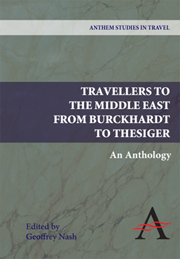Book contents
- Frontmatter
- Contents
- Acknowledgements
- Introduction
- PART ONE THE COMING OF EMPIRE 1800–1879
- The Ottoman Empire and Egypt
- Arabia
- 1 Travels in Arabia
- 2 Travels in Arabia
- 3 Personal Narrative of a Pilgrimage to Al-Madinah and Meccah
- 4 Narrative of a Year's Journey Through Central and Eastern Arabia
- 5 A Pilgrimage to Nejd
- 6 Travels in Arabia Deserta
- Persia
- PART TWO COLONIALISM AND RESISTANCE 1880–1950
- Bibliography
2 - Travels in Arabia
from Arabia
Published online by Cambridge University Press: 05 March 2012
- Frontmatter
- Contents
- Acknowledgements
- Introduction
- PART ONE THE COMING OF EMPIRE 1800–1879
- The Ottoman Empire and Egypt
- Arabia
- 1 Travels in Arabia
- 2 Travels in Arabia
- 3 Personal Narrative of a Pilgrimage to Al-Madinah and Meccah
- 4 Narrative of a Year's Journey Through Central and Eastern Arabia
- 5 A Pilgrimage to Nejd
- 6 Travels in Arabia Deserta
- Persia
- PART TWO COLONIALISM AND RESISTANCE 1880–1950
- Bibliography
Summary
After Carsten Neibuhr's visit to Muscat in 1764, James Wellsted, a naval officer who travelled there in 1834–5, was among the first to explore the important districts of inner Oman including the Jebel Akhdar mountain range. Dedicated to the young Queen Victoria, Travels in Arabia was published in 1838. Its political context was the British expedition against the Bani Bu Ali tribe, which had converted to Wahhabism and defeated a British force in 1821. Wellsted was part of General Lionel Smith's expedition of 1834 that all but wiped the tribe out. Wellsted characterizes Sultan of Oman Sayid Said bin Sultan as liberal, tolerant, personally abstemious, and a keen ally of the British – ‘probably, if any native prince can with truth be called a friend to England it is the Imam of Maskat.’ The Sultan received him warmly furnishing him with presents and promising every assistance. According to Robin Bidwell (1976), Wellsted ‘had the greatest of all gifts in an explorer – an intuitive understanding of the people that he met and a sympathy with them’ (207). An Austrian editor of Travels in Arabia (1838) writes: ‘The description of Nizwa and above all the ascent of the Jabal Akhdar represents the highlight of Wellsted's book’ (Scholz, 1978: XVI) Wellsted's writing visits some of the key themes of travellers to Arabia: Bedouin nobility, Arab treatment of women, and the freedom the desert gave.
- Type
- Chapter
- Information
- Travellers to the Middle EastAn Anthology, pp. 52 - 57Publisher: Anthem PressPrint publication year: 2009



